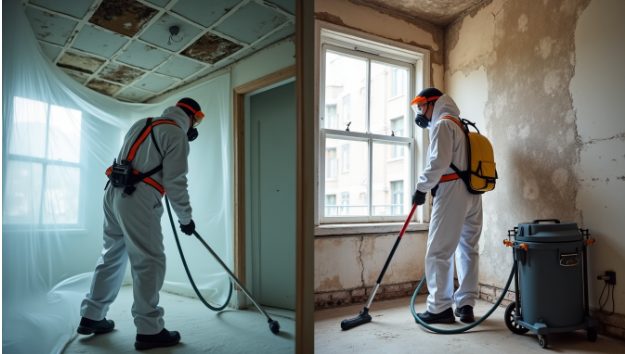Abatement in Construction: Expert Guide to Choosing Between Removal vs. Remediation
Abatement in construction is a vital part of protecting public health, particularly in buildings built before 1978. Federal regulations now require sellers and landlords to tell buyers and renters about possible lead-based paint hazards. This shows how serious these concerns really are.
Both processes deal with hazardous materials differently. Abatement completely removes problems like mold, asbestos, and lead to stop them from coming back. Remediation takes a different path by tackling why these problems happen in the first place. Choosing between these options can be tricky, especially since materials like asbestos were common before 1980 and can lead to serious health problems if disturbed.
Let us guide you through the main differences between abatement and remediation. This will help you make a smart choice for your construction project. You'll learn about implementation strategies and regulatory requirements that will protect your property and everyone in it.
Understanding Abatement vs. Remediation in Construction
Construction professionals need to understand the key differences between abatement and remediation approaches for hazardous materials. Abatement's main focus lies in permanently removing or neutralizing known hazardous materials through specific safety protocols. The process requires either complete removal of building components or creating protective barriers that prevent exposure.
Specialists start the abatement process with detailed inspection and testing. They create quarantine areas using polyethylene sheets after identifying hazardous materials to stop airborne particles from spreading. The EPA's guidelines mandate specific work practices during demolitions and renovations, and property owners must notify appropriate state agencies about asbestos-containing materials.
In stark comparison to this, remediation covers a broader scope. The process aims to reverse, eliminate, or stop processes that create ongoing dangers. To cite an instance, mold remediation involves removing existing mold and finding moisture sources that could cause future growth. This detailed approach creates comprehensive reports that outline contamination sources, testing requirements, and long-term solutions.
OSHA's strict guidelines govern both processes. Their regulations require specific protective equipment like respirators, disposable gloves, coveralls, and rubber boots. Asbestos-related work demands specialized certification, and professionals must pass clearance examinations by independent, certified risk assessors.
A key difference appears in long-term monitoring needs. Well-executed abatement needs minimal ongoing monitoring since it offers a more permanent solution with better safety margins. The remediation process often needs continuous assessment and adjustment of solutions to ensure they work long-term.
Site conditions and specific hazards determine the choice between abatement and remediation. Lead contamination typically needs abatement but not remediation, as proper removal or encapsulation eliminates immediate threats. All the same, both processes remain crucial to construction safety and federal regulation compliance.
Factors That Determine Your Abatement Strategy
The choice of a proper abatement strategy in construction projects depends on many key factors. The amount and state of hazardous materials affect how quickly they need to be removed. Materials with high concentrations need immediate action because they create bigger risks of direct exposure.
How easy it is to reach these materials makes a big difference too. When building users can easily access materials, they need to be removed first due to exposure risks. The way people use the building also matters - high-traffic areas need quick attention, though you might still use parts of the building during the work.
A building's age and condition affect abatement choices a lot. Buildings from 1930 to 1950 face high risks because builders used hazardous materials like asbestos heavily during this time. Materials that are breaking down release more fibers than those in good shape.
Money plays a huge role in picking abatement strategies. Complete removal gives you the best solution but costs a lot. You can spread out the removal over time to handle budget limits by tackling the riskiest areas first.
The work gets more complex when many parties are involved. This is especially true in buildings people still use, where keeping work areas separate from occupied spaces is vital.
You need to know how building parts connect to each other. Taking out one contaminated part might affect nearby materials or the building's strength. That's why you need complete surveys and risk checks before finalizing any plans.
Sometimes temporary fixes help while planning permanent removal. You might use plastic barriers with duct tape as a short-term solution. But these need constant checking and will need permanent fixes later.
The final choice needs to balance what's technically possible with real-world limits. This means looking at your resources, time needs, and how it affects other building systems and people. A good abatement plan also thinks about future upkeep and how well the chosen methods will work long-term.
Step-by-Step Implementation Process
A successful abatement process demands close attention to detail and strict compliance with regulatory guidelines. The first step involves appointing a qualified Asbestos Program Manager (APM) who oversees all asbestos-related activities. The APM's responsibilities include selecting contractors and verifying their certifications and training credentials.
Trained inspectors must get a full picture of hazardous materials and their condition before work begins. Their evaluation helps create the right containment strategy. The strategy typically uses clear polyethylene sheeting barriers and negative air pressure systems.
Safety protocols become crucial after setting up containment measures. Workers need proper Personal Protective Equipment (PPE) designed specifically for asbestos-related tasks. Their equipment must include respirators with HEPA filters, protective coveralls, and disposable gloves.
The APM's work permit system helps maintain strict control over the work area. Contractors must get authorization before starting any project that could disturb asbestos-containing materials (ACM). The team also sets up decontamination procedures so workers can safely exit contaminated areas without spreading hazardous materials.
Air monitoring plays a key role during active abatement. Qualified professionals regularly test air samples inside and outside the containment area. These measurements help keep safety standards high and confirm asbestos levels stay within acceptable limits.
The project requires clearance testing for completion. Independent environmental technicians visually inspect substrate surfaces to confirm complete ACM removal. Air sampling professionals then collect samples using specialized equipment that operates at about 10 liters per minute.
Project documentation remains critical for closure. The APM keeps detailed records of all abatement activities, including inspection reports, air monitoring data, and waste disposal documentation. These records ensure regulatory compliance and serve as valuable reference material for future maintenance or renovation work.
Conclusion
The choice between abatement and remediation depends on several factors, as each approach serves a different purpose. Abatement provides permanent solutions by removing hazardous materials completely, while remediation tackles the mechanisms that prevent future problems.
Safety must come first in both processes. The work to be done requires qualified professionals who follow protocols strictly and maintain complete documentation. The upfront costs might look high, but protecting occupant health through proper hazard management is a great way to get long-term value.
Project success largely depends on getting a full picture and planning carefully. Qualified inspectors should identify all potential risks before work starts to ensure appropriate containment measures and safety protocols. Testing confirms the project works, and detailed documentation helps maintain compliance.
Each construction project comes with its own set of challenges. Material concentration, building age, accessibility, and occupancy patterns all affect strategy selection. A careful review of these elements, combined with proper implementation, ensures successful hazard management that protects property value and occupant wellbeing.

